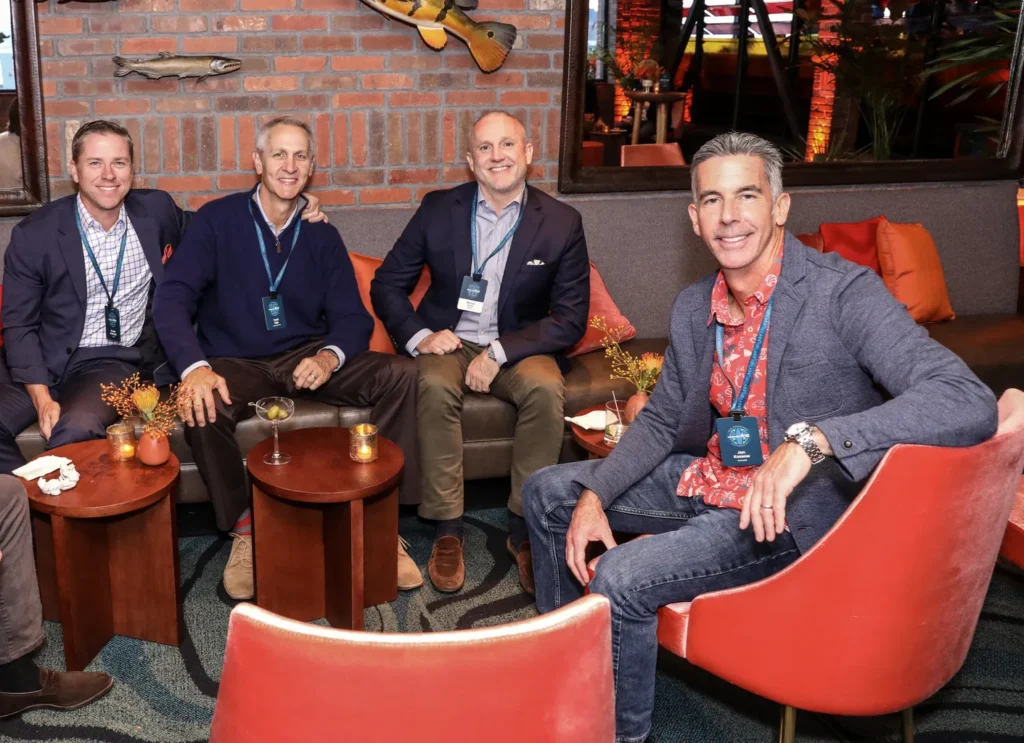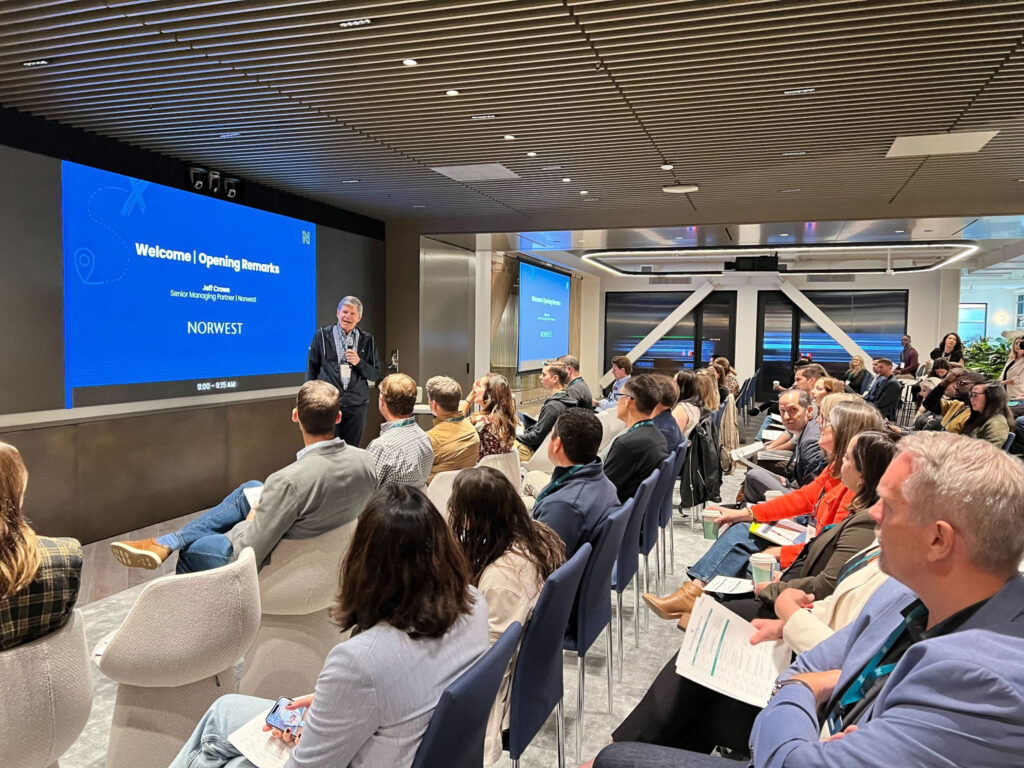Thank You!
A milestone 2024 would not have been possible without our community of visionary founders, CEOs, co-investors, business partners, and staff.

New Year, New Fund:
NVP 17 Announced
Our newest $3 billion venture and growth equity fund backs visionary entrepreneurs and best-in-class founding teams as they build the next generation of companies.
2024 by the Numbers
943M
Total Invested Capital
82
New and Follow-On Investments
258
Active Portfolio Companies
15.5B
Capital Under Management
Celebrating Portfolio
Liquidity Milestones
Congratulations to these Norwest portfolio companies on achieving IPOs, acquisitions, and other significant liquidity events in 2024.





NASDAQ: MBX




NSE: SWIGGY



NASDAQ: ZBIO
2025 in Focus:
9 Investor Predictions
2025 arrives with optimism and growth potential across the healthcare, enterprise, and consumer sectors. Our investors believe these trends will gain traction in the new year.
Deepfake attacks will increasingly make headlines in 2025 and enterprises will begin allocating budget to thwart the threat vector.
As complex agentic AI systems gain ubiquity in the next 3-5 years, a new role will emerge: the AI systems engineer. This new quality assurance and oversight role will become essential to enterprises as they manage and continuously optimize AI agents.
The rising use of weight loss drugs will increase demand for aesthetics - as people lose fullness in their face and experience loose skin in other areas, they will seek fillers, lasers and plastic surgery to solve skin elasticity after weight loss.
Driven by demand to modernize legacy technology, 2025 will be a continued growth year for software adoption in many blue collar sectors including construction, energy, and government infrastructure.
CHRIS SCULLIN
We expect to see advances in therapeutics that address autoimmunity, driven by multivalent strategies and accelerated by discoveries in T-cell regulation in treating cancer.
In 2025, interventional psychiatry, including TMS, ketamine, and related medicines, will gain widespread adoption for its profound impact on depression.
We expect the quick commerce industry in India to grow by 80-100% in 2025 as consumer demand continues to increase for instant delivery services. This rapid growth will not only transform the e-commerce industry, it will also impact how consumers shop, engage with brands, and experience convenience in their daily lives.
HEAD OF NORWEST INDIA
Neuromodulation will continue to emerge as a breakthrough therapy for chronic health conditions that were historically treated with medications including migraine, stroke, and autoimmune diseases such as rheumatoid arthritis.
AI-enabled services will transform revenue cycle management in the healthcare industry by increasing efficiency, automating complex tasks, and improving processes like claims management and reimbursements.
NORWEST INDIA
We're Honored: Awards & Recognition
Most of the attention and credit for our success goes to our portfolio companies—and rightly so. Norwest also enjoyed its share of the limelight in 2024. Kudos to all who had a hand in earning these awards.
Power Moves: Executive Hires & Promotions
Congratulations to the Norwest leaders who received promotions this year and a hearty welcome to those who joined our team.
Leading the Conversation
Beyond growing and supporting our portfolio, many Norwest leaders shared their insights on a range of topics. Scroll through their best thought leadership from 2024.
Blog
/ Outlook
October 29, 2024
More than 40 countries are holding national elections in 2024 and the stakes have never been higher for verifying credible information. People around the world have seen how deepfakes — synthetic media that leverage AI to replace one object with another — can deceive audiences and influence votes.
These AI techniques can produce text, images, videos, or audio recordings that seem real, but are artificially generated from public data. Consider these examples:
- Video deepfake: A finance worker at a multinational firm in Hong Kong was duped into sending $25 million to attackers who used AI-based deepfake video-cloning to create a multi-person “video conference” where everyone was fake, including the company’s CFO who supposedly authorized the transaction.
- Audio deepfake: A hacker successfully breached Retool’s multi-factor authentication (MFA) process and stole granular customer data by replicating the voice of an IT employee and getting another employee to divulge the MFA security token, resulting in access to the sensitive data.
- Audio deepfake: An attacker used recordings of Wiz CEO and Co-Founder Assaf Rappaport speaking at a conference to create a deepfake voice message that asked employees for their credentials.
Sure, manipulated media is nothing new (Photoshop, anyone?), but the generative AI models available today have taken the sophistication to a new level, significantly lowering the barrier to creating convincing deepfakes. And the threat doesn’t stop at politics. Celebrities, brands, and enterprises are also common targets.
We’ve had recent discussions with business leaders who told us they contended with deepfake attacks connected to major company events such as IPOs, M&As, product releases, and earnings calls—posing substantial risks to their businesses.
As investors in innovative security and trust startups, including current portfolio companies Heeler, Uptycs, Veza, and ActiveFence, we are following this nascent market closely. We hold ongoing conversations with security executives, as well as founders of deepfake security companies. In this blog, we tackle key questions such as: Should companies be adding deepfake security tools to their technology stacks? How strong is the market demand for deepfake security software? Which deepfake detection solutions and use cases are most mature and commercially viable today?
Deepfake Attack Vectors and Related Risks Expand
Conceptually, deepfakes are a more sophisticated type of phishing attack, designed to deceive recipients or audiences and prompt a specific action or reaction. While many companies have protocols in place to detect and prevent email- and text-based phishing attacks, they haven’t yet deployed the same safeguards for deepfakes and their varied modalities. Detecting deepfakes presents a new challenge: engaging and seemingly authentic content that’s much harder to ignore than an email with a suspicious link.
Not all deepfake attacks have business or monetary gain as their goals, either. Taylor Swift was the subject of a malicious deepfake text-to-image campaign that gained traction on X (Twitter).
These attacks underscore the significant risks deepfakes can pose to enterprises and individuals. Gartner identified at least five:
- Stolen intellectual property and brand identity
- Brand reputation damage in customer-facing content
- Proliferation of disinformation
- Fraud in identity verification
- Monetary loss
As malicious deepfake attacks generate headlines and fear, companies and individuals will look for ways to detect and neutralize them. Accordingly, the legislative landscape and commercial market for deepfake security are evolving quickly in response.
Industry and Legislative Attempts to Reign in Deepfakes
The tech industry and state governments are spearheading ways to address deepfakes. Industry coalitions are setting standards for verifying the origins of digital content. At the same time, state lawmakers are attempting to legislate deepfake activity.
A number of notable tech companies have collaborated to form the Coalition for Context Provenance & Authenticity (C2PA), an initiative to develop technical standards for certifying the source and history of media content. The C2PA framework provides a helpful foundation, but its efficacy depends on widespread adoption by content creators, platforms, and consumers.
Several states have also enacted laws to criminalize the malicious use of specific categories of deepfakes. Although they vary somewhat, California and Texas laws allow victims of sexually explicit deepfakes to sue the creators. These states also allow political candidates to take legal action if deepfake videos are distributed close to elections. Although clearly on the radar of lawmakers, officials still need to figure out whether the US needs a federal law to deliver more consistency and clarity about deepfake activity.
The Market for Deepfake Security Tools Is Evolving Quickly
Mitigating the impact of deepfakes could eventually require organizations to deploy an array of security measures. Although most companies are not yet incorporating deepfake detection and mitigation tools into their technology architecture, that could change.
When we reach that tipping point, most will focus on solutions across the six categories outlined in Figure 1.

Figure 1. The 6 Categories of Deepfake Security Tools for Enterprises
Companies are already providing specialized solutions in each of these areas. Figure 2 identifies some category leaders in the current deepfake security market.

Figure 2. Deepfake & Brand Security Market Map
Some of these categories are more mature than others, presenting different levels of commercial potential.
Deepfake Image, Video, and Audio Detection
Deepfake image, video, and audio detection tools have broad application in both the public and private sectors. Existing use cases in call centers, HR, brand protection, account recovery, and fraud prevention bode well for their long-term viability.
They’re a hot topic among cybersecurity leaders as well, as evidenced by Reality Defender winning the RSA Sandbox competition earlier this year. However, deepfake detection is a capital-intensive endeavor, requiring heavy investments in R&D to keep ahead of fraudsters. It’s the typical cat-and-mouse game of cybersecurity: attackers continuously refine their deepfake models for more sophisticated attacks and the detection tools have to scramble to keep up.
Identity Verification
Similarly, identity verification is a necessary capability for deepfake detection, but most enterprises are already using a combination of tools to achieve adequate protection. Legacy solutions such as Nuance (voice biometrics) and Pindrop (voice and behavioral analysis) are well established.
Content Watermarking
Content watermarking makes intuitive sense for commercially licensed AI models, but open source models could be used freely without application of watermarks. Long-term success may be contingent on the development and acceptance of standards like C2PA by creators and AI-creation toolmakers alike.
Brand Protection and Content Licensing
Companies that provide brand protection and content licensing tools benefit from having customers (celebrities and brands) who are highly motivated to protect their images, likenesses, and reputations. This would be akin to the protections provided under the Digital Millennium Copyright Act (DMCA) of 1998.
An automated takedown feature meets a clear customer need, and sales cycles are relatively short. Providers of these solutions also have a built-in growth opportunity if they offer licensing features that allow celebrities or brands to monetize unique content.
Narrative Attack Protection
Narrative attack protection is becoming more important as disinformation campaigns are deployed for commercial gain. These AI-driven tools monitor and analyze large amounts of data, detect false narratives, and generate insights into how to counteract them. Banks, healthcare companies, and even advertising agencies have all deployed solutions in this area. However, a critical hurdle for providers is demonstrating adequate ROI to justify ongoing adoption.
What’s Next for Deepfake Security
Deepfake technology has greatly accelerated over the past few years, and the advent of generative AI tools has only made it easier to create and distribute synthetic content. The potential for deepfake attacks poses considerable risk. However, our observation of the current market is that companies tend to look for deepfake security solutions after they have been attacked when they face pressure from the board or executives to implement solutions quickly.
With annual contracts reaching upwards of $250,000, will enterprise customers proactively seek out these tools? Will media coverage of corporate deepfake attacks—which are sure to come—raise awareness and demand from businesses who want to keep their brands out of those headlines?
As the deepfake security landscape continues to evolve, we will continue to assess its potential, identifying which specific verticals and enterprise use cases are most compelling to the market. Innovative solution providers that can differentiate themselves from more basic, reactive competitors will emerge as leaders in the space.
We believe deepfake security tools are poised to become a part of the enterprise security stack as attacks progress in sophistication. In the interim, we see leaders of targeted functional teams such as HR and customer support adopting these solutions and championing them internally.
If you’re already building one of those solutions or you just have thoughts on our perspective, reach out to Dave Zilberman or Bayan Alizadeh.

Blog
/ Outlook
October 15, 2024
Blog
/ Investment
April 2, 2024
Blog
/ Outlook
December 7, 2023
The Power of Presence
There’s no substitute for being together in person. In 2024, our team attended industry events, hosted dinners, and held internal celebrations. We look forward to more bonding in 2025.











































